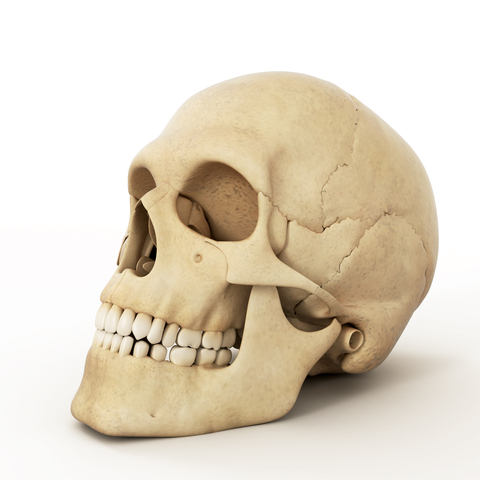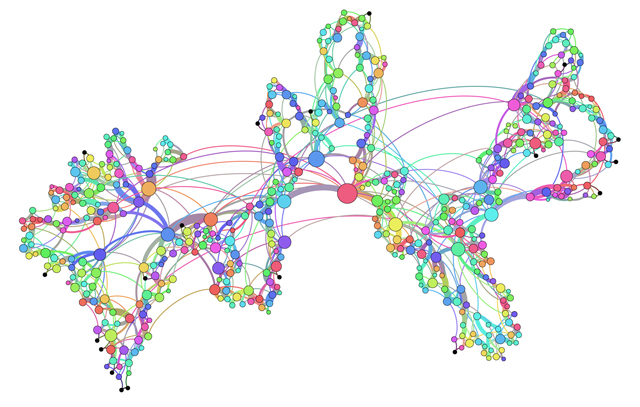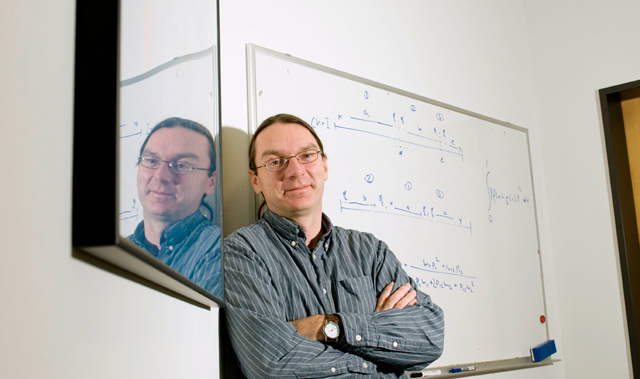Evolution is an opportunist

Feathers are a classic example of co-optation, or exaptation. They are found in the fossils of flightless ancestors of birds, and then they became a means for flying birds.
Evolution is filled with examples of opportunism . Organisms infected with viruses adapt the genetic material left by the latter for their needs. Metabolic enzymes somehow learned to refract light in the eye lens. Mammals use the stitches on the bones of the skull so that the young can squeeze through the birth canal. The classic example is that feathers appeared in the fossil record even before the ancestors of modern birds soared into the sky.
In these cases, evolution has applied co-optation for the new use of the existing feature in suitable conditions. These cases teach us that the way a particular feature of an organism is used does not always explain its origin.

All vertebrates have stitches on the skull, but only mammals use them to pass through the birth canal. This is an example of an escapation for the birth process.
')
In 1982, Stephen Jay Gould and Elisabeth Vrba came up with a name for this phenomenon: exstration . They described it as an analogue of the well-known concept, adaptation . The adaptation adapts the existing properties for new needs, and the adaptation builds the properties with the help of natural selection.
The sequence and arrangement of bones in the four limbs of animals living on land is an excursion for walking, since their limbs were originally intended for swimming. Conversely, changes in the shape of bones and muscles are examples of adaptation, Gould and Vrba wrote.
This concept has been controversial since its inception, mainly due to the fact that in the historical context of evolution it was quite difficult to distinguish between the forces of exaptation and adaptation. Until recently, evidence of co-optation of features was limited to a few examples being studied — for example, the evolution of feathers. But examples from the morphological, behavioral and molecular field make some biologists suspect that this phenomenon played a more serious role in evolution than is commonly believed.
A study published in Nature can be called the first attempt to comprehensively identify potential exposes. According to third-party researchers, the results of a study focused on metabolism complement episodic examples and take the first step in determining the contribution of excretion to development.
Scientists used computational modeling to create random metabolic systems that are configured to use the same type of fuel — and these systems had the latent potential to use other types of fuel that they had not previously used. Thus, a hypothetical organism, devoid of the usual source of food, could live on a new one. Such a possibility of changing the power leads to the appearance of exaptation.
“I think it’s becoming clearer that the fact that exclusion plays a significant role in the evolution of biologically important processes,” says Joe Thornton , a molecular evolutionary biologist from the University of Chicago and Oregon, who is not associated with this study. “There is growing evidence of the importance of the processes that Gould and Vrba paid attention to.”
In search of hidden potential
To find traces of expotation, it is necessary to immerse yourself in history - which is difficult to do for most biological properties. Andreas Wagner and Aditya Barve from the University of Zurich avoided this problem by simulating evolution and checking the results. They concentrated on metabolism, using a computational representation of the networks of reactions used by organisms to break down food and produce the molecules necessary for survival and growth.
They tried to find out: if the network has adapted to use a specific carbon source of energy, such as glucose, can it use other carbon sources — for example, adenosine or acetate ?

Because such a large-scale study cannot be performed with living organisms, Barve and Wagner began with a network model of 1,397 reactions used with E. coli. Then they launched the evolution of this network, replacing one reaction of the network with another, randomly selected from the set of known reactions involved in metabolism. Although science has not documented all possible metabolic reactions in nature, the metabolism is rather well studied, and it is easier to work with it than with other systems.
Replacement occurred with one condition: the network must retain the ability to use glucose. This requirement was analogous to natural selection, rejecting non-working replacements.
Barve and Wagner created 500 new metabolic networks, each of which was the result of 5000 substitutions. They studied each about the possibility of metabolism of any of the 49 carbon sources, except glucose. It turned out that 96% of networks could use several carbon sources. The average network could work on almost five of them. In other words, several potential exits were attached to one adaptation (survival on glucose).
Results were not limited to glucose-based networks. Wagner and Barve repeated the experiment, substituting each of 49 other carbon-containing molecules instead of glucose, and found that most of the randomly created networks could work on several carbon sources.
They also found that this flexibility cannot be explained simply through the so-called. "Metabolic proximity" of carbon sources. In other words, the network using glucose could not easily switch to using a molecule that is easy to get from glucose. “If this were the only explanation for the scope of the exportation, it would be boring,” Wagner said. “It would be a necessary consequence of the principles of biochemistry.”
However, the complexity of the network, apparently, determines its flexibility. The more reactions there are on the network, the greater the potential for exaptation. “Many of the functions of organisms could be made much easier,” says Wagner. “This result suggests that complexity can have many side effects — for example, potentially useful new properties.”
Beyond Metabolism
The lens of the eye is filled with crystalline proteins, which refract rays of light and focus them on the retina. Crystallines look as if they were taken from other places where they performed tasks unrelated to this function. For example, alpha-crystallin can be found in the heart and other places where it protects other proteins from stress, says Joram Piatigorsky, an honorary scientist at the National Eye Institute of the National Institutes of Medicine. Other crystallins, he said, can serve as catalysts for metabolic reactions.
The work of Barve and Wagner complements a growing set of examples of molecular exfoliation. Thornton, for example, studied the evolution of hormones and their receptors that fit together, like a key and a lock. He found that under favorable conditions, half of this partnership could, through cooptation, create a new hormone-receptor system.
35 years ago, Gould and Vrba suggested that repetitive DNA sequences, known as transposons , or jumping genes acquired from viruses, may not have a direct function, but be used to take advantage in the future. Since then, researchers have demonstrated that transposons play an important role in the evolution of pregnancy. "They are derived from viruses, but they can be used for purposes that they were not adapted to," says Günter Wagner , an evolutionary biologist at Yale University, a former scientific director Andreas Wagner (not a relative).
Balance change
The study of metabolism suggests that the lion's share of the existing features of the organisms are the result of exits. Metabolic nets, chosen according to one principle, survival on glucose, had the ability to survive on average in almost five other sources. Barve and Wagner argue that this discovery forces us to rethink the assumptions about the origin of the beneficial properties of organisms.
Wagner explains it this way: suppose a microbiologist isolates a new bacterium and discovers that it can survive on a fairly common carbon source. “A microbiologist will immediately say that the bacterium survives on this source due to the adaptation that helped the bacteria survive in the past,” says Wagner. “But our observations say that this is not necessarily the case.” Maybe this is one of the properties obtained as a side effect. "

Andreas Wagner
“If our discovery turns out to be true in general, it will become very difficult to distinguish properties obtained as a result of adaptation from properties obtained not because of adaptation,” says Wagner.
Even before the advent of the study, these two concepts — adaptation and deployment — were difficult to distinguish. Gould and Vrba admit that one can flow from the other, and that in any complex features one can find the presence of both concepts.
Others argue that adaptation from exportation cannot be distinguished at all, and that the definition of expropriation is redundant. "Nothing used today was created for current purposes," says Greger Larson , an evolutionary biologist at the University of Durham. He and his colleagues found a decrease in the frequency of mentioning exaptation compared with adaptation in the literature on evolutionary biology and blames the lack of a clear separation of concepts. They suggest overriding this term.
Due to evolutionary uncertainty, it is rather difficult to say that a particular feature has emerged as a result of pure adaptation. The wings of birds and bats can be called the result of arm ekzpatsia. But the structural changes that followed cannot be called adaptation, since “we are talking about historical randomness; This is not something that can be verified, ”says Mark Norel, a spinal paleontologist from the American Museum of Natural History, who worked with Vrba.
Others argue about the existence of differences between stockpile and adaptation, even if they are sometimes quite subtle. “Indeed, almost everything can be called a modification of some previous forms,” Thornton wrote in an e-mail. - But it's not that". The determining factor is the work of natural selection.
Thornton offered two examples: if new mutations allow the enzyme to eliminate the toxic effects of a pesticide present in the environment, this will be an adaptation. It appeared as a result of natural selection. If a hormone that was previously responsible for regulating a certain process co-opted into a hormone that regulates another process, this is an excuse, since the hormone did not evolve as a result of natural selection.
The influence of Barv and Wagner’s theoretical approach has allowed them to demonstrate with certainty the potential for being exempt outside of historical contexts. Randomly collecting metabolic networks, they were able to circumvent the baggage of evolution, burdening real microbes. But for a true understanding of the role of exaptation in evolution, they will need to confirm the results obtained with the help of living organisms. They hope to achieve this, although it is not yet known in what way. “We are still thinking about how this can be done,” says Wagner. “This is a really difficult task.”
Source: https://habr.com/ru/post/370321/
All Articles